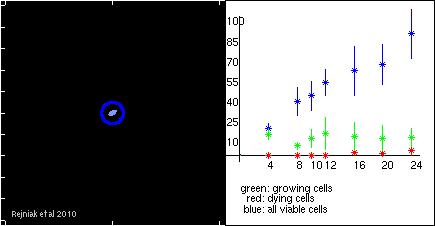Development of a mutated acinus (multicellular spheroid without a hollow lumen)
 |
Goals:
Use the biomechanical IBCell model to reproduce the development of a mutated acinus (a spheroid filled with tumor cells and without the hollow lumen).
Mathematical Model: A classical fluid-structure interaction technique called the Immersed Boundary Method was used to model cell growth and division and all interactions between elastic cells (composed from linear Hookean springs) and the viscous incompressible cytoplasm inside the cells, and the surrounding medium. This method solves 2D or 3D partial differential Navier-Stokes equations. Computational tools: The model is coded using the programming language Fortran and all images and movies are made using the Matlab system. Author: Kasia Rejniak: labpages.moffitt.org/rejniakk |
| Simulation movie: this simulation presents a growing cluster of mutated cells that are not able to form an epithelial structure (one layer of cells enclosing the hollow lumen). Instead they form a constantly growing mass of cells that resembles a tumor. Right panel shows experimental data (stars) that represent the number of viable cells, the number of growing cells (green) and the number of dying cells (red). The solid lines show the same quantities calculated from the simulation movie. |
 |
MCF10A-HER2-YVMA experimental data (fluorescently stained images of cell nuclei) |